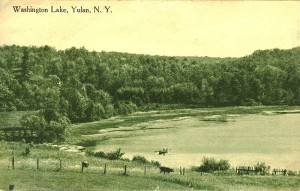
New York’s draft cleanup, the detection and putting into uniform of young men who fooled themselves into thinking that they could save their precious skins by evading the selective service law, started on a prodigious scale. More than 42,000 were caught in New York’s boroughs and the nearby cities of New Jersey.
A great specially organized police force of 20,000 men began what is officially called a canvass of the city and metropolitan district, including Hoboken, Jersey City, and Newark…
The proportion of proved slackers was probably less than 3 per cent. The others had left their draft credentials at home or were not of conscript age. The hunt will go on. The canvassers have been asked to be more careful than many of them were the first day.
One of the most important immediate results of the concerted raid was the arrest and identification of five actual deserters from the United States Army.—Republican Watchman, Monticello, July 1, 1918.
Sullivan County Resorts Still Alive with Guests
Eldred Sojourners: The Labor Day weekend finds many Brooklynites enjoying country life at Eldred’s Bradley House and Echo Hill Farm.
The delightful weather of the past few weeks has kept everyone in the best of spirits. Living out of doors during the day has been supplemented by sleeping out of doors at night. The fad is prevalent throughout this section, especially among the younger people. Brooklynites are at Highland Cottage and the Washington Lake House.
The large number of bathers and of boats to be seen at Highland Lake give evidence that the last week of August has been a busy one for proprietors of the hotels. Guests from Brooklyn are at Highland Lake House and Sunset.—Brooklyn Daily Eagle, September 1, 1918.
Browning Automatic Rifle
By June 1918, Winchester was in full production of the Browning automatic rifle (B.A.R.), and delivered 4,000 guns. In July there were 9,000 units produced.
Both the Colt and Marlin-Rockwell Corporations began soon after Winchester was in full production. The three companies produced 706 rifles per day, and a total of 52,000 B.A.R.s were delivered by the end of the war.The Browning automatics began to arrive in France by July 1918.
The U.S. Army’s 70th Infantry Division, the first unit to receive the Browning automatic rifles, used them in action for the first time on September 13, 1918.
The Browning Automatic Rifles were used extensively during the Meuse-Argonne Offensive and would impress the allies. France would request 15,000 automatic rifles to replace what they had.—wikipedia.org.
From Echo Hill and Mountain Grove, pp. 367, 371, 374.







